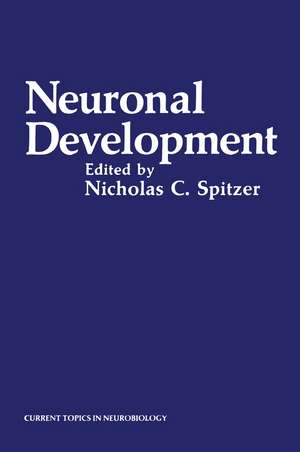Neuronal Development: Current Topics in Neurobiology
Autor Nicholas C. Spitzeren Limba Engleză Paperback – 25 noi 2012
Preț: 647.08 lei
Preț vechi: 761.27 lei
-15% Nou
Puncte Express: 971
Preț estimativ în valută:
123.84€ • 127.93$ • 103.06£
123.84€ • 127.93$ • 103.06£
Carte tipărită la comandă
Livrare economică 25 martie-08 aprilie
Preluare comenzi: 021 569.72.76
Specificații
ISBN-13: 9781468411331
ISBN-10: 1468411330
Pagini: 452
Ilustrații: XXIII, 424 p.
Dimensiuni: 152 x 229 x 24 mm
Greutate: 0.6 kg
Ediția:Softcover reprint of the original 1st ed. 1982
Editura: Springer Us
Colecția Springer
Seria Current Topics in Neurobiology
Locul publicării:New York, NY, United States
ISBN-10: 1468411330
Pagini: 452
Ilustrații: XXIII, 424 p.
Dimensiuni: 152 x 229 x 24 mm
Greutate: 0.6 kg
Ediția:Softcover reprint of the original 1st ed. 1982
Editura: Springer Us
Colecția Springer
Seria Current Topics in Neurobiology
Locul publicării:New York, NY, United States
Public țintă
ResearchCuprins
1. Cell Lineage in the Development of the Leech Nervous System.- 1. Introduction.- 2. Leech Embryogenesis.- 3. A Novel Cell Lineage Tracing Method.- 4. Development of Germinal Bands.- 5. Origin of the Segmental Ganglia.- 6. Cell-Specific Ablation.- 7. Conclusion.- 8. References.- 2. Origins of the Nervous System in Amphibians.- 1. Introduction.- 2. The Theory of Compartmentation.- 3. Predictions Made from the Theory and Their Experimental Verification.- 4. Critique of the Theory of the Organizer.- 5. Compartment vs. Organizer Theories.- 6. References.- 3. Monoclonal Antibodies to Embryonic Neurons: Cell-Specific Markers for Chick Ciliary Ganglion.- 1. Introduction.- 2. Materials and Methods.- 3. Results.- 4. Discussion.- 5. References.- 4. Genetic Manipulation of Sensory Pathways in Drosophila.- 1. Introduction.- 2. The Experimental Material.- 3. A Theoretical Framework.- 4. Compartments Boundaries and Peripheral Nerves.- 5. Central Projections in Mutants of the Antennapedia Complex.- 6. Central Projections in Mutants of the Bithorax Complex.- 7. Analysis.- 8. References.- 5. Embryonic Development of Identified Neurons in the Grasshopper.- 1. Introduction.- 2. The Grasshopper Nervous System.- 3. Grasshopper Embryology.- 4. Neuronal Precursor Cells.- 5. Early Axonal Pathways.- 6. Cell Lineage of the Median Neuroblast.- 7. Cell Lineage of Midline Precursor 3.- 8. Properties of the Progeny of a Single Precursor.- 9. Morphological Differentiation.- 10. Physiological Differentiation.- 11. Biochemical Differentiation.- 12. Temporal Sequence of Development.- 13. Segment-Specific Cell Death.- 14. Segment-Specific Differentiation.- 15. Limb Bud Removal Experiments.- 16. Conclusions and Questions.- 17. References.- 6. Nerve Fiber Growth and Its Regulation by Extrinsic Factors.- 1. Introduction.- 2. Behavior of the Growing Nerve Fiber Tip.- 3. Structure of the Growing Nerve Fiber.- 4. Mechanism of Nerve Fiber Growth.- 5. Regulation of Nerve Fiber Growth by Environmental Factors.- 6. Regulation of Nerve Fiber Growth by Chemotaxis.- 7. Future Prospects.- 8. Conclusions.- 9. References.- 7. Pioneer Fibers: The Case for Guidance in the Embryonic Nervous System of the Cricket.- 1. Introduction.- 2. First Connections between Periphery and Center: How and When?.- 3. The Events of Sensory Embryogenesis: A Hypothetical Program.- 4. A Matter of Scale.- 5. Periphery and Center.- 6. References.- 8. Mechanisms for the Formation of Synaptic Connections in the Isogenic Nervous System of Daphnia Magna.- 1. Introduction.- 2. The Adult Visual System.- 3. Development of the Visual System.- 4. Experimental Perturbations of Development.- 5. Mechanisms for the Formation of the Eye-Lamina Projection.- 6. References.- 9. Cell Death in Neuronal Development: Regulation by Trophic Factors.- 1. Introduction.- 2. Neuronal Cell Death.- 3. Nerve Growth Factor.- 4. Parasympathetic Neurons.- 5. Other Ganglionic Neurons.- 6. CNS Neurons.- 7. Conclusions.- 8. References.- 10. Neuromuscular Synapse Elimination: Structural, Functional, and Mechanistic Aspects.- 1. Introduction.- 2. General Features of Polyneuronal Innervation and Synapse Elimination.- 3. Mechanisms Underlying Synapse Elimination.- 4. Models and Possible Molecular Mechanisms.- 5. Overview and Conclusion.- 6. References.- 11. Regeneration and Regulation in the Developing Central Nervous System with Special Reference to the Reconstitution of the Optic Tectum of the Chick Following Removal of the Mesencephalic Alar Plate.- 1. Introduction.- 2. Review of Previous Studies of Regeneration in the Developing Central NervousSystem.- 3. Recent Observations on the Regeneration of the Chick Optic Tectum.- 4. References.











